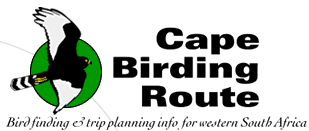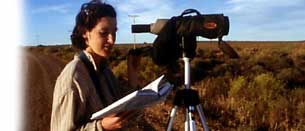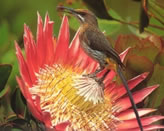Katbakkies:
The
steep, rocky slopes and dense acacia thicket of the small
picnic site often called Katbakkies, where the Karoo meets
the escarpment of the Koue Bokkeveld (‘cold buck-country’)
mountains, offers fine and varied birding. It is best known
as the classic site for Cinnamon-breasted
Warbler (p.85*), a peculiar and often evasive warbler
of arid, rocky hillsides. In addition, the acacia thicket
offers several dry western specials, including Pririt
Batis, Fairy Flycatcher and Layard’s
Titbabbler.
This
site, which we shall call Katbakkies in keeping with popular
birding tradition, is correctly named ‘Peerboomskloof’
or ‘Skitterykloof’; the true, now ignored Katbakkies
lies 20 km to the west. The obscure term ‘Katbakkies’
refers to the ‘dickey-seat’ on the rear of old motor
cars, and the steep pass is so-named because it had to be
ascended backwards, using the more powerful reverse gear.
Just 3.5 km west of the R355, the road enters an aloe-lined
gap in the mountains and proceeds to wind steeply up into
the moister, fynbos-like scrub of the Koue Bokkeveld. Just
past the initial passage into the mountains, a small track
(1 on map overleaf) leads off to the left and immediately
into the picnic site. A few concrete tables, a tap and a rustic
toilet are set alongside impenetrable sweet-thorn (Acacia
karroo) thicket that bristles with fearsomely huge thorns.
Acacia trees line the riverbed leading into the top of the
picnic site, where there is also a tiny, reed-bordered dam.
Below the picnic site, the valley broadens and there is a
small seep (at 2) that feeds a dense reedbed. The rock-strewn
valley sides and precipitous, red-cliffed escarpments presiding
over the picnic area are covered with a remarkable density
of Aloe comosa, an unusually tall aloe restricted to
a tiny area in this region.
These
slopes are also legendary for being most accessible site in
the world to see Cinnamon-breasted
Warbler (p.85*). Familiarity with this species’
call is absolutely essential, as it is otherwise almost impossible
to locate. The pair on the slopes adjacent to the band of
red cliffs at 3, a short walk up the riverbed from the picnic
site, are arguably South Africa’s most tape-pressured
birds, yet they nest here annually and still regularly respond
to provocation. Having said that, we do urge ardent visitors
to be very sparing with playback at this site in order to
keep disturbance to a minimum. The birds tend to call loudly
in short bursts, usually from exposed positions on a rock
or aloe, then remain silent for another ten or fifteen minutes
— so don’t despair. Even during each bout of calling,
they are constantly on the move, delving around the bases
of bushes and scurrying rodent-like between rock jumbles.
There
are several pairs of birds within a few hundred metres of
the picnic site. For the sure-footed, another good area to
investigate is the steep ridge that runs parallel to the right-hand
side of the road. Begin at the bend in the road at 4, 150
m from the picnic site turn-off. Climb straight up the slope
and on to the top of the ridge, aiming to skirt the right-hand
edge of the cliff at 5. It is well worth the scramble, as
this ridge has the advantage of keeping one above the birds,
making them much easier to locate as they call intermittently
among the rocks below. It is then possible to search for the
birds rather than over-play the tape.
As
you bound along the slopes after warblers, you’re also
likely to bump into Southern Grey Tit, Layard’s
Titbabbler, Mountain Chat and Rock Martin.
Pale-winged Starlings regularly overfly the valley,
and Ground
Woodpeckers (p.105*) sometimes hurl invective from
the ridges. Dusky Sunbirds occasionally move into the
area. As ever, it is worth keeping an eye skyward for Black
and Booted Eagles and Rock Kestrel.
The
acacia thicket in the picnic site is usually alive with birds,
even at midday. Essentials here are Fairy Flycatcher
and Pririt Batis.
Other interesting birds of this habitat are Acacia
Pied Barbet, White-backed Mousebird, African
Marsh Warbler (summer), Yellow-bellied Eremomela,
White-throated Canary and Cape Bunting. Three-banded
Plover frequent the boggy lower seep, while the adjacent
reedbeds host resident Levaillant’s Cisticola
and Cape Reed Warbler.
|


